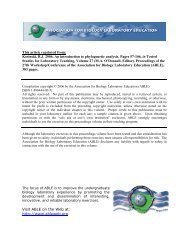Lumbriculus variegatus - Association for Biology Laboratory Education
Lumbriculus variegatus - Association for Biology Laboratory Education
Lumbriculus variegatus - Association for Biology Laboratory Education
You also want an ePaper? Increase the reach of your titles
YUMPU automatically turns print PDFs into web optimized ePapers that Google loves.
Pulsation rate of blackworms 133<br />
8. Place the slide on the microscope and observe the worm at scanning power (4x) or using a<br />
stereoscope.<br />
*NOTE: Since intense light exposure can fry your worms and/or make them hyperactive, use a<br />
low amount of light and avoid exposing your worms <strong>for</strong> long periods of time to the light.<br />
9. Find a segment as close to the middle of the worm as possible. Count the number of pulsations<br />
that pass through this point on the worm over 30 seconds. Multiply this by two to get rate per<br />
minute. Repeat this procedure two more times. Then, find the average pulsation rate per minute<br />
(record data in Table 1).<br />
10. Place this worm into a weigh boat containing a small amount of spring water (just enough to<br />
cover the worm). Label the weigh boat so that you can recall which worm is where.<br />
11. Obtain another worm and have your partner run through #6-9 with this worm. This worm should<br />
be placed in a different weigh boat. Record the data in Table 1.<br />
12. Run through #6-9 using a third worm. Place this worm into its own weigh boat too. Record<br />
your data in Table 1.<br />
13. Now, run through #6-9 using three of the middle third segment worms. Record your data in<br />
Table 1.<br />
Discussion<br />
Table 1. Basal Pulsation Rate <strong>for</strong> Uncut and Cut Blackworms<br />
Uncut Blackworms Average Pulsation Rate<br />
1<br />
2<br />
3<br />
Average Rate <strong>for</strong> Uncut:<br />
Cut Blackworms<br />
1<br />
2<br />
3<br />
Average Rate <strong>for</strong> Cut:<br />
1. Put your results on the board. Your TA will calculate the average pulsation rate <strong>for</strong> both the cut<br />
and uncut worms <strong>for</strong> the entire class. What is the class average <strong>for</strong> the cut worms? For the uncut<br />
worms?<br />
2. How did the class average pulsation rate <strong>for</strong> the cut worms compare to the class average <strong>for</strong> the<br />
uncut worms?
















